What is Fascia on a House? (As Opposed to Trim)
Author: Omar Alonso | Editor: Omar Alonso
Review & Research: Jen Worst & Chris Miller
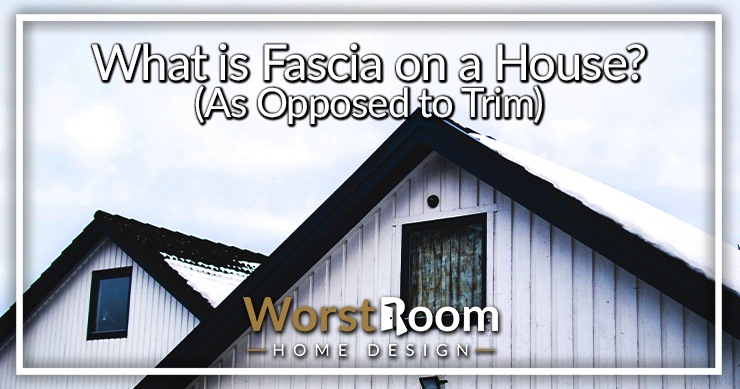
Your home's exterior is crucial for aesthetic appeal and protection from outside elements. One commonly overlooked but essential component of this exterior is the fascia. But what is fascia on a house?
Not only does this vital part of your roofline ensure optimal protection against water damage, but it also maintains structural integrity by supporting key components like gutters, rafters, and soffits.
In this blog post, we'll reveal more about the fascinating roles these seemingly unassuming boards play in enhancing your home's safety and aesthetics. So, without further ado, let’s get right into it!
Understanding Fascia on a House
Simply put, fascia is a horizontal board that runs along the lower edge of a roof's eaves and acts as a protective barrier for the roof trusses. In this section, we’ll delve into the intricacies of fascia and provide insight into one of the most significant parts of a roof. So, let’s get started!
Definition & Purpose of Fascia
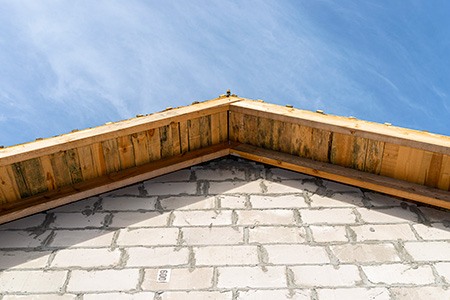
With both an aesthetic and functional purpose, fascia is a vital component of your home's exterior. Essentially, it refers to the long, horizontal boards that run along the lower edge of your roofline, connecting and supporting essential roofing materials such as shingles or tiles.
One primary purpose of fascia is securing gutters and drain pipes to your house to divert water from your home's foundation. By doing so, it helps prevent water damage on various parts of the structure while simultaneously keeping moisture levels in check for optimal insulation performance. A house can't go long without gutters.
Apart from its functional role in maintaining the internal structure, fascia enhances curb appeal by creating a visually appealing transition between roofing materials and siding or cladding. In short, it has you covered in every department.
Types of Fascia Materials
Since fascia materials determine the durability and appearance of your roofline, it’s essential to choose the right type for your home. And as with everything in the world, the correct one will differ from case to case.
Made from cedar, redwood, pine, spruce, or fir, wood fascias are the most traditional pick. These fascias are known for their natural beauty and versatility and offer a classic look that appeals to many homeowners. However, they also require regular maintenance to prevent rotting and decay.
PVC (polyvinyl chloride) is another option that offers a low-maintenance alternative with exceptional resistance to moisture damage. This material also comes in various colors, allowing you to customize it according to your preferences.
Then there’s aluminum: an extremely durable option for those wanting a lightweight but sturdy fascia board material. It resists rusting and does not require painting due to its factory-applied coating. Plus, it comes in various colors, so what’s not to love?
Lastly, there’s vinyl: an increasingly popular choice that combines durability with minimal maintenance requirements. This fascia material provides excellent resistance against extreme weather conditions, including snowstorms and intense sun exposure. Amazing, right?
All four of these are fantastic choices, so it’s up to you to determine which material is ideal for your home. Take your time and conduct sufficient research to make the right decision.
Differences Between Trim & Fascia
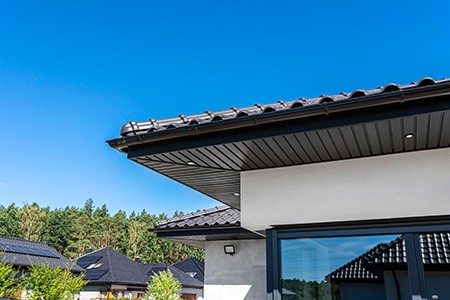
What is fascia on a house compared to typical trim? While exterior trim and fascia both serve to enhance the appearance of a home's facade, they have distinct functions and locations as parts of a roof. Exterior trim refers to the material used to encase windows and is responsible for providing a finished look and sealing gaps that allow water or air infiltration.
On the other hand, fascia is an essential barrier against water damage and supports gutters as they channel rainwater away from your property. Furthermore, it acts as "transition trim” and bridges the gap between your home's exterior walls and roof tiles to create a seamless appearance.
All in all, the primary distinction between exterior trim and fascia revolves around their specific roles in protecting your home.
Why Proper House Fascia Maintenance Is Critical
Proper fascia maintenance is critical for protecting against water damage, preventing rot and decay, enhancing curb appeal, and supporting the roof structure. Keep reading to learn more about the vast benefits of this maintenance!
Protecting Against Water Damage
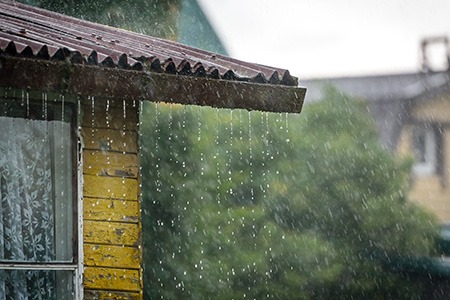
Proper fascia maintenance plays a crucial role in protecting your home against water damage. Considering that water infiltration can cause significant structural damage to the fascia board, roof structure, and interior walls, it’s essential not to take this matter lightly.
Fascia wraps, also known as capping, provide an extra layer of protection against moisture-related issues that occur from heavy rainfall or standing water. Cleaning fascia every 2-3 years will defend against and delay these problems greatly.
Sealing the edges of the fascia board prevents this water from seeping into the gaps between the brickwork and the fascia board, which can lead to rotting or decay. Doesn’t that sound like a relief?
Preventing Rot & Decay
Adequate fascia maintenance is also necessary to prevent rot and decay. Wood rot can occur due to moisture buildup, which is common in soffit and fascia boards exposed to rain or snow. Inadequate ventilation, too, exacerbates the problem.
This is why it’s essential to regularly inspect the fascia boards and look for any signs of damage or decay. By doing so, you can successfully prevent costly repairs.
Ensuring that there are no leaks in gutters or downspouts can also help protect the fascia from water damage. Additionally, painting and sealing the wood regularly can help extend its lifespan, preventing premature decay and minimizing expensive replacements.
Enhancing Curb Appeal
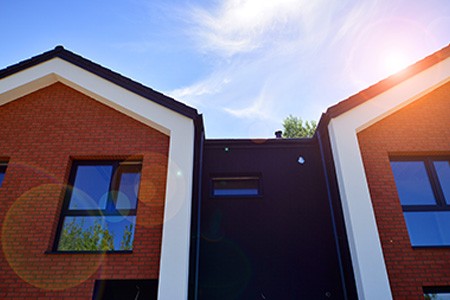
People ask what is fascia on a house because they notice it. It's an attractive feature. Proper maintenance of the fascia on your home can significantly enhance its curb appeal. This is one of the key architectural elements that contribute to a property's exterior design.
If left unmaintained, peeling or cracking paint and sagging boards can make a house look old and unkempt. However, if you opt for materials like aluminum or vinyl when replacing your fascia, it’ll not only add durability and weatherproofing but also improve the property’s aesthetics with different colors and textures.
Supporting Roof Structure
Last but certainly not least, fascia maintenance plays a vital role in supporting your home’s roof structure. These boards are designed to hold gutters in place and cap the edges of rafters, providing essential support for the roofline.
In addition, adequately sealed fascia can protect against winter weather conditions like snow accumulation or ice damming, which is a huge perk if you ask us.
On the other hand, incorrectly installed or unmaintained fascia can cause an unsightly gap between the shingles and the guttering system, which could cause significant water damage.
To protect your house and keep these critical components functioning at their best, make sure to include regular gutter cleaning and inspection in your yearly home maintenance routine.
All in all, maintaining proper fascia is necessary for not only enhancing curb appeal but also protecting the overall integrity of your roofing structure.
A well-maintained fascia system provides sturdy protection against harsh weather conditions while ensuring that rainwater drains from vulnerable areas, thus keeping moisture out of your attic space.
Signs of Fascia Damage or Decay & How to Fix Them
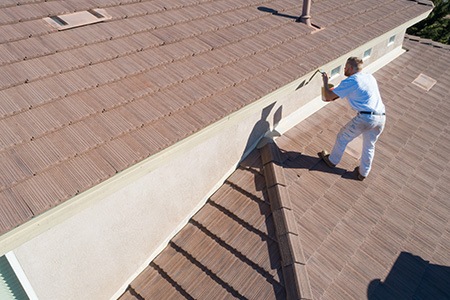
If you notice peeling or cracking paint, sagging or warping boards, and water stains or leaks on your fascia board, it is essential to address them promptly to prevent further damage and maintain the integrity of your roof. Here’s what you need to know.
Peeling or Cracking Paint
Peeling or cracking paint on your home’s fascia is a clear sign that there may be underlying damage or decay. This may occur due to several reasons, including moisture, poor ventilation, and age.
Failing to address these issues can lead to more severe problems down the line, the likes of which include mold growth and wood rot. That’s why it’s essential to quickly identify the root cause of the issue and make repairs before any further damage occurs.
Sagging or Warping Boards
Sagging or warping boards are one of the most common signs of fascia damage or decay. When the board is exposed to moisture over an extended period, it weakens and eventually sags under the roof’s weight.
A poorly maintained gutter system, too, can negatively affect your fascia board's integrity and cause water to overflow.
To prevent significant structural decay and water damage down the line, be sure to address sagging or warping boards right away. This simple step will make all the difference in the world.
Water Stains or Leaks
Water stains and discoloration on fascia boards indicate water infiltration and potential issues with the roof and gutters. When water makes its way behind gutters, it can cause critical damage to fascia boards and lead to them rotting over time.
So, if you spot any stains on your boards, you must handle the problem promptly. This will not only protect your home from further damage but also enhance its curb appeal. Talk about a win-win.
Overall, never underestimate the impact of peeling or cracking paint, sagging or warping boards, and water stains or leaks. If left unaddressed, they can deteriorate the integrity of your roof, which is just about the last thing we want. In a nutshell, keep an eye out at all times.
So, What Is Fascia on a House, Then?
We hope this blog post provided you with ample insight into this crucial component of your home’s exterior. Now, you can choose some fascia boards for your residence and enjoy a comfortable life. Just be sure to regularly maintain them for optimal protection.
So what is fascia on a house, then? All in all, fascia plays a more prominent role in protecting your house and maintaining structural integrity than you might think. From protecting against water damage to preventing decay to enhancing curb appeal, fascia enhances your home in more ways than one.



